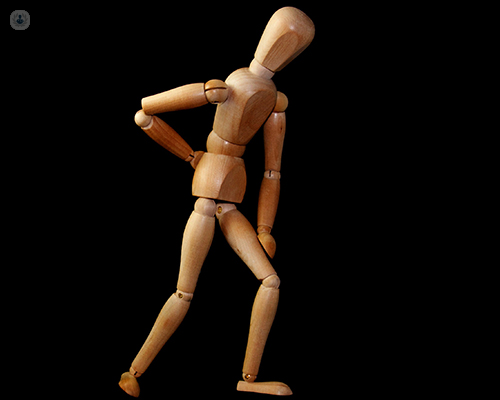

What is spinal osteoarthritis?
Spinal osteoarthritis is a degenerative disease that affects the spine, causing the cartilage between the vertebrae to wear out. This can in turn cause significant pain in your back.
Spinal osteoarthritis is a common condition in the UK and low back pain is the most frequent cause of work sick days.

What are the symptoms of spinal osteoarthritis?
In many cases, spinal osteoarthritis is present without symptoms, which is why it is often diagnosed incidentally by radiographs that are performed for other reasons. When symptoms do occur they can include:
- pain in the back, in the buttock or in the posterior compartment of the thigh, when moving or when carrying some weight
- in later stages, sciatica, which can include shooting pains down the back and legs, weakness and numbness
What are the causes of spinal osteoarthritis?
Spinal osteoarthritis becomes more common with age, with the majority of people affected over the age of 50. You are more likely to experience the condition if:
· you have a genetic problem that causes your cartilage to degenerate
- you suffer an injury to your lower back
- you have an occupation or play a sport that puts repeated stress on the joints in your lower back
- you are overweight or obese
Over the age of 50, men are more likely to experience spinal osteoarthritis than women.
Can spinal osteoarthritis be prevented?
Although you cannot prevent osteoarthritis, you can reduce your chances of developing the condition by:
- maintaining good posture at work
· making sure any heavy lifting is carried out properly and with good form
- keeping physically active
- maintaining a healthy weight
How is spinal osteoarthritis diagnosed?
If you visit the GP with pain in your lower back they are likely to refer you for a scan such as an X-ray or MRI. This will allow a radiologist to see the bones and joints in your lower back clearly and examine any potential damage to the cartilage. You may also undergo blood tests to rule out other causes of your symptoms.
How is spinal osteoarthritis treated?
The first line of treatment is investigating what you can do yourself to improve the condition.
If you are overweight or do not do any exercise, then making lifestyle changes to achieve a healthy weight and become physically active can make significant difference to the symptoms you experience. Strength-building exercises, for example, can strengthen your muscles, which are in turn better able to support your joints.
Beyond this, treatment can involve:
- painkillers
- anti-inflammatory medication
- massage
- heat and cold treatment
- spinal injections
In severe cases, especially in cases of sciatica, a form of spinal surgery known as spinal decompression may be considered. This aims to increase the space in the spinal canal so that the nerves inside are no longer compressed, and no longer cause symptoms of sciatica.
